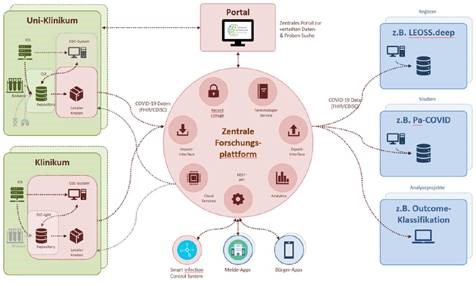CODEX – Implementation Concept for Building a COVID-19 Data Exchange Platform

The current situation requires swift action to contain the ongoing pandemic. Using the data platforms of the Medical Informatics Initiative (MII), routine clinical data is to be made effectively accessible. In the demonstrator study on comorbidities and rare diseases, it could be clearly demonstrated that the data integration centers (DIZ) being established as part of the MII are already capable of rapidly generating valuable new insights.
Architecture, Project Organization, and Timeline
The Architecture of the National Data Platform (see diagram) is divided into decentralized components ("NUM nodes" operated by the Data Integration Centers) and a central component that supports data provision and utilization. In the first expansion stage, the central platform will be operational within two months after the project start. It is supplemented by a central portal for data and biomaterial search. The provision of COVID-19-relevant data is carried out by the decentralized components to the central platform, but also directly from already established decentralized components to national study registries.
The decentralized part of the platform ("NUM nodes") builds on existing infrastructures of the Medical Informatics Initiative (MII), particularly the Data Integration Centers, which were established at nearly all German university hospitals during the current funding phase of the MII (2018–2021). These Data Integration Centers provide the organizational and technical framework for supplying data from clinical primary systems and also offer the technical capabilities to integrate new components and processes (e.g., local COVID registries and SmICS at the respective university hospitals). With the technical infrastructure for implementing the MII’s National Broad Consent and for supporting local Use and Access Committees, they form a key component for the legally compliant and controlled secondary use of existing data. The decentralized components of the platform are also essential for rapidly and systematically rolling out new guidelines, documentation standards, and analytical tools nationwide.
The site-specific components of the platform are complemented by a central platform with its own data repository, enabling collaborative research on the integrated data and supporting healthcare processes in the context of COVID-19. The central data repository contains pseudonymized data from various sources, especially the Data Integration Centers, but potentially also from public health authorities and data voluntarily provided by citizens (e.g., via apps). Once in operation, the platform will make it possible to roll out new services for healthcare providers, public health authorities, and citizens on a large scale. This will both efficiently support public health measures and provide a robust data foundation for making critical decisions in managing the COVID-19 crisis. The unified platform of central components and local nodes enables fast and qualified decision-making based on reliable data and the delivery of patient-specific diagnostics and therapies across the entire network.

Further information
Project funding
The collaborative project was funded by the Federal Ministry of Education and Research (BMBF) from August 2020 until the end of 2022 as part of the Network University Medicine (NUM).

- Research
- SEPE
- FDPG-PLUS
- LAOLA
- MoveGroup
- SU-TermServ
- CAWIP
- Completed Projects
- ABIDE_MI
- CARE for CAYA
- CODEX
- NMDR
- NMDR2
- Assistance systems for children using bikes
- Geriatric Mobility Screenings (GerMobiS)
- MLTriage
- Critical Systems Engineering - Socio-technical Vehicle Systems (The Car that Cares)
- Critical Systems Engineering Living Lab - Medical Process Modeling (CSE LL-MPM)
- AEQUIPA II
- AEQUIPA Technology
- Publications
